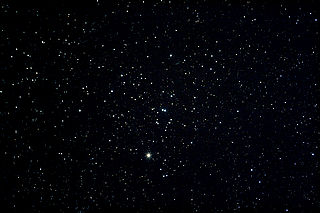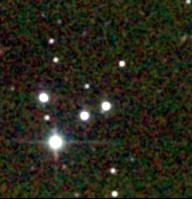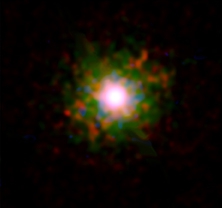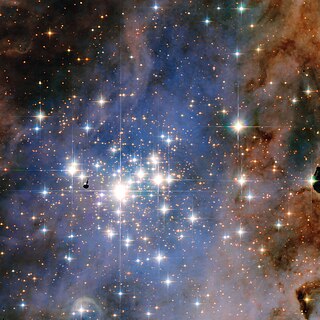
A planetary nebula, abbreviated as PN or plural PNe, is a type of emission nebula consisting of an expanding, glowing shell of ionized gas ejected from red giant stars late in their lives.

The Hyades is the nearest open cluster and one of the best-studied star clusters. Located about 153 light-years away from the Sun, it consists of a roughly spherical group of hundreds of stars sharing the same age, place of origin, chemical characteristics, and motion through space. From the perspective of observers on Earth, the Hyades Cluster appears in the constellation Taurus, where its brightest stars form a "V" shape along with the still-brighter Aldebaran. However, Aldebaran is unrelated to the Hyades, as it is located much closer to Earth and merely happens to lie along the same line of sight.

A quasi-satellite is an object in a specific type of co-orbital configuration with a planet where the object stays close to that planet over many orbital periods.

Messier 73 is an asterism of four stars in the constellation of Aquarius. An asterism is composed of physically unconnected stars that appear close to each other in the sky as seen from Earth.

The Scutum–Centaurus Arm, also known as Scutum-Crux arm, is a long, diffuse curving streamer of stars, gas and dust that spirals outward from the proximate end of the Milky Way's central bar. The Milky Way has been assumed since the 1950s to have four spiral arms although the evidence for this has never been strong. In 2008, observations using the Spitzer Space Telescope failed to show the expected density of red clump giants in the direction of the Sagittarius and Norma arms. In January 2014, a 12-year study into the distribution and lifespan of massive stars and a study of the distribution of masers and open clusters both found evidence for four spiral arms.
Mount Lemmon Survey (MLS) is a part of the Catalina Sky Survey with observatory code G96. MLS uses a 1.52 m (60 in) cassegrain reflector telescope operated by the Steward Observatory at Mount Lemmon Observatory, which is located at 2,791 meters (9,157 ft) in the Santa Catalina Mountains northeast of Tucson, Arizona.
NGC 4463 is an open cluster in the constellation Musca. The young planetary nebula He 2-86 is believed to be a member of the cluster.

Westerlund 2 is an obscured compact young star cluster in the Milky Way, with an estimated age of about one or two million years. It contains some of the hottest, brightest, and most massive stars known. The cluster resides inside a stellar breeding ground known as Gum 29, located 20,000 light-years away in the constellation Carina. It is half a degree from the naked eye Cepheid variable V399 Carinae.

NGC 5466 is a class XII globular cluster in the constellation Boötes. Located 51,800 light years from Earth and 52,800 light years from the galactic center, it was discovered by William Herschel on May 17, 1784, as H VI.9. This globular cluster is unusual insofar as it contains a certain blue horizontal branch of stars, as well as being unusually metal poor like ordinary globular clusters. It is thought to be the source of a stellar stream discovered in 2006, called the 45 Degree Tidal Stream. This star stream is an approximately 1.4° wide star lane extending from Boötes to Ursa Major.
In astronomy, an open cluster family is a group of approximately coeval young open star clusters located in a relatively small region of the Galactic disk.

Not to be confused with Cygnus X-1

(311999) 2007 NS2 is an asteroid and Mars trojan orbiting near the L5 point of Mars.

Trumpler 14 is an open cluster with a diameter of six light-years (1.8 pc), located within the inner regions of the Carina Nebula, approximately 8,980 light-years (2,753 pc) from Earth. Together with the nearby Trumpler 16, they are the main clusters of the Carina OB1 stellar association, which is the largest association in the Carina Nebula, although Trumpler 14 is not as massive or as large as Trumpler 16.

WR 21a is a binary star in the constellation Carina. It includes one of the most massive known stars and is one of the most massive binaries.

XX Persei is a semiregular variable red supergiant star in the constellation Perseus, between the Double Cluster and the border with Andromeda.

NGC 1901 is an open cluster in the Dorado Constellation. It has a bright middle and is a little rich, with stars from 7th magnitude downwards. The celestial object was discovered on 30 December 1836 by the British astronomer John Herschel. The cluster is sparsely populated with GAIA data suggesting a membership of around 80 stars. It is considered unlikely it will survive its next pass through the Milky Way’s galactic plane in about 18 million years time.

U Lacertae is a spectroscopic binary star in the constellation Lacerta.
WR 12 is a spectroscopic binary in the constellation Vela. It is an eclipsing binary consisting of a Wolf-Rayet star and a luminous companion of unknown spectral type. The primary is one of the most luminous stars known.

NGC 5617 is an open cluster in the constellation Centaurus. NGC 5617 forms a binary open cluster with Trumpler 22. It lies one degree west-northwest of Alpha Centauri.




















